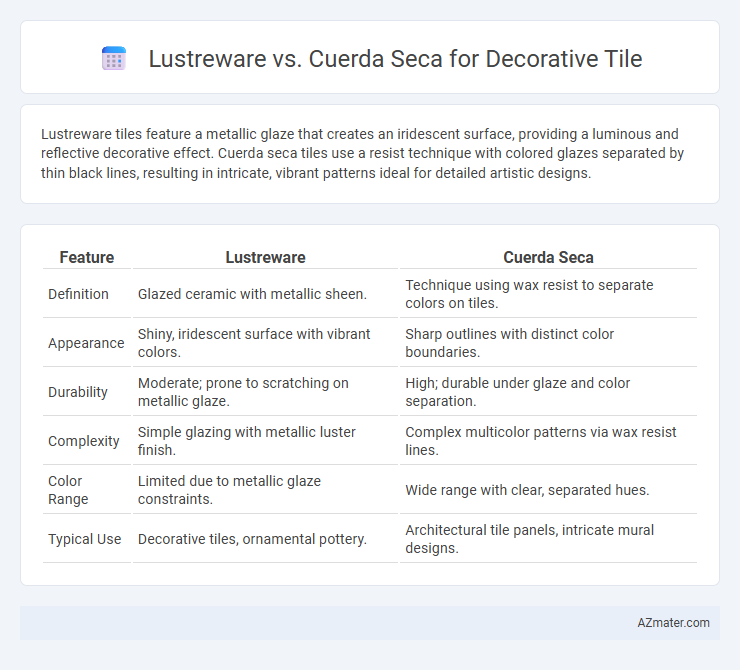Lustreware tiles feature a metallic glaze that creates an iridescent surface, providing a luminous and reflective decorative effect. Cuerda seca tiles use a resist technique with colored glazes separated by thin black lines, resulting in intricate, vibrant patterns ideal for detailed artistic designs.
Table of Comparison
| Feature | Lustreware | Cuerda Seca |
|---|---|---|
| Definition | Glazed ceramic with metallic sheen. | Technique using wax resist to separate colors on tiles. |
| Appearance | Shiny, iridescent surface with vibrant colors. | Sharp outlines with distinct color boundaries. |
| Durability | Moderate; prone to scratching on metallic glaze. | High; durable under glaze and color separation. |
| Complexity | Simple glazing with metallic luster finish. | Complex multicolor patterns via wax resist lines. |
| Color Range | Limited due to metallic glaze constraints. | Wide range with clear, separated hues. |
| Typical Use | Decorative tiles, ornamental pottery. | Architectural tile panels, intricate mural designs. |
Introduction to Decorative Tiles
Decorative tiles are valued for their aesthetic appeal and intricate designs, with Lustreware and Cuerda Seca representing two distinct glazing techniques. Lustreware uses metallic oxides to create iridescent, shimmering surfaces, adding a luxurious, reflective finish to tiles. Cuerda Seca employs a resist technique to separate vibrant glazes with thin black lines, resulting in bold, crisp patterns ideal for intricate decorative tile work.
Overview of Lustreware Technique
Lustreware technique involves applying a metallic glaze to ceramic tiles, creating an iridescent, shimmering surface that enhances decorative appeal. This method uses precious metal oxides, such as silver or copper, fired at a lower temperature to achieve a reflective, lustrous finish distinct from the matte or glossy appearance of cuerda seca tiles. Lustreware is prized for its vibrant, multi-dimensional beauty and durability in both indoor and outdoor decorative tile applications.
The Cuerda Seca Method Explained
The Cuerda Seca method involves applying a greasy resist line between colored glazes on decorative tiles, preventing colors from mixing during firing and creating crisp, distinct patterns. This technique is prized for producing intricate designs with vibrant, long-lasting colors, especially in traditional Spanish and Moorish tile work. Unlike Lustreware, which relies on metallic luster application, Cuerda Seca emphasizes precise delineation of motifs through waxy resist lines that dry and fire without smudging.
Historical Origins of Lustreware
Lustreware, originating in the Middle East around the 9th century, is distinguished by its iridescent metallic glaze achieved through a complex firing process involving metal oxides. This technique spread to Europe and became prominent in Islamic and later Spanish ceramics, representing a significant advancement over the Cuerda seca method, which uses wax resist to separate colors during glazing. Lustreware's historical significance lies in its innovative use of chemistry and artistry, marking a pivotal evolution in decorative tile production.
Development of Cuerda Seca in Tile Art
Cuerda seca, developed in Moorish Spain during the 10th century, revolutionized decorative tile art by enabling intricate multi-colored designs through a wax resist technique that separated glazes with thin dark lines. This innovation allowed artisans to create vibrant, detailed patterns with greater precision compared to the earlier metallic sheen of lustreware, which relied on a limited palette and complex firing processes. The cuerda seca method became instrumental in Islamic and Spanish tilework, influencing decorative arts with its vivid imagery and lasting durability.
Materials and Tools Used in Both Methods
Lustreware tiles are crafted using ceramic glazes enriched with metallic oxides, requiring high-temperature kiln firing to achieve their distinctive shiny finish, and tools include brushes and sponges for glaze application. Cuerda seca tiles involve applying colored glazes separated by a greasy resist paste containing manganese oxide, which creates dark outlines to prevent color mixing during firing; tools used include squeegees or brushes to apply the resist lines. Both techniques necessitate precise control over kiln temperature and timing, with Lustreware emphasizing metallic lusters and Cuerda seca focusing on vibrant, well-defined color patterns separated by dry lines.
Visual Characteristics: Lustreware vs Cuerda Seca
Lustreware tiles exhibit a distinctive iridescent sheen created by a metallic glaze, resulting in a glossy and reflective surface that shifts color with light angles. Cuerda seca tiles feature crisp, separated color areas outlined by a grease-resist line, producing sharp, intricate patterns without blending or smudging. The metallic luster of Lustreware contrasts with the vivid, matte clarity of Cuerda seca, making each technique visually unique in decorative tile art.
Durability and Maintenance Comparison
Lustreware tiles offer a glossy, iridescent finish that requires careful handling to prevent surface scratches and maintain longevity, making them moderately durable but more prone to wear in high-traffic areas. Cuerda seca tiles, characterized by their raised, wax-resist lines and vibrant glazes, provide enhanced durability due to their protective barriers that reduce glaze cracking and chipping, resulting in easier maintenance. Both tile types demand regular cleaning, but cuerda seca's design minimizes dirt accumulation and fading, outperforming lustreware in long-term resilience and upkeep efficiency.
Artistic Applications and Cultural Significance
Lustreware and Cuerda seca represent two distinct decorative tile techniques with profound artistic applications and cultural significance. Lustreware, known for its iridescent glaze achieved through metallic oxides, enhances tiles with shimmering, light-reflective surfaces often seen in Islamic and Spanish art. Cuerda seca, distinguished by its separated colored glazes outlined with oily substance lines, allows intricate, multicolored designs typical of Moorish and Mexican tile art, embodying rich cultural narratives and artisanal heritage.
Choosing Between Lustreware and Cuerda Seca for Modern Design
Lustreware offers a glossy, smooth finish with vibrant, uniform colors achieved through metallic glaze techniques, ideal for sleek, contemporary interiors. Cuerda seca provides intricate, sharp lines with multiple colored glazes separated by wax resist, perfect for detailed, patterned designs in modern spaces emphasizing craftsmanship. Choosing between lustreware and cuerda seca depends on whether you prioritize glossy, seamless aesthetics or richly textured, graphic tile art in your decorative tile applications.

Infographic: Lustreware vs Cuerda seca for Decorative Tile
 azmater.com
azmater.com